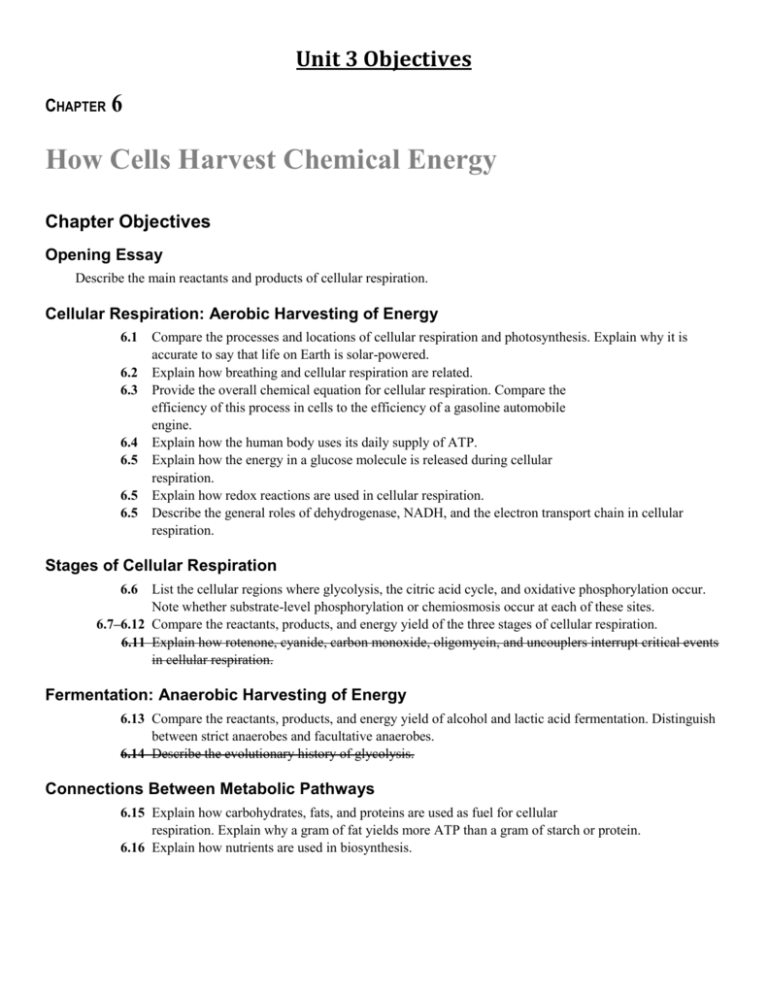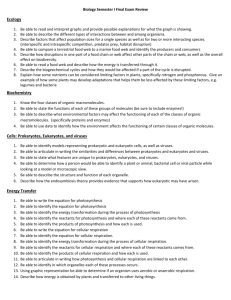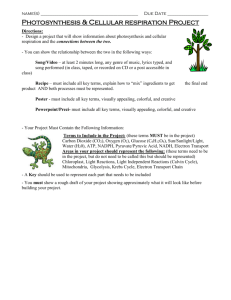Unit 3 Objectives 11
advertisement

Unit 3 Objectives CHAPTER 6 How Cells Harvest Chemical Energy Chapter Objectives Opening Essay Describe the main reactants and products of cellular respiration. Cellular Respiration: Aerobic Harvesting of Energy 6.1 6.2 6.3 6.4 6.5 6.5 6.5 Compare the processes and locations of cellular respiration and photosynthesis. Explain why it is accurate to say that life on Earth is solar-powered. Explain how breathing and cellular respiration are related. Provide the overall chemical equation for cellular respiration. Compare the efficiency of this process in cells to the efficiency of a gasoline automobile engine. Explain how the human body uses its daily supply of ATP. Explain how the energy in a glucose molecule is released during cellular respiration. Explain how redox reactions are used in cellular respiration. Describe the general roles of dehydrogenase, NADH, and the electron transport chain in cellular respiration. Stages of Cellular Respiration 6.6 List the cellular regions where glycolysis, the citric acid cycle, and oxidative phosphorylation occur. Note whether substrate-level phosphorylation or chemiosmosis occur at each of these sites. 6.7–6.12 Compare the reactants, products, and energy yield of the three stages of cellular respiration. 6.11 Explain how rotenone, cyanide, carbon monoxide, oligomycin, and uncouplers interrupt critical events in cellular respiration. Fermentation: Anaerobic Harvesting of Energy 6.13 Compare the reactants, products, and energy yield of alcohol and lactic acid fermentation. Distinguish between strict anaerobes and facultative anaerobes. 6.14 Describe the evolutionary history of glycolysis. Connections Between Metabolic Pathways 6.15 Explain how carbohydrates, fats, and proteins are used as fuel for cellular respiration. Explain why a gram of fat yields more ATP than a gram of starch or protein. 6.16 Explain how nutrients are used in biosynthesis. CHAPTER 7 Photosynthesis: Using Light to Make Food Chapter Objectives Opening Essay Explain how plants can be used as a renewable energy source. Explain why this is better than burning fossil fuels. An Overview of Photosynthesis 7.1 7.2 7.3 7.4 7.5 Define autotrophs, heterotrophs, producers, and photoautotrophs. Describe the structure of chloroplasts and their location in a leaf. Identify specifically where most light energy is converted to chemical energy. Explain how plants produce oxygen. Describe the experiments that revealed the source of the oxygen produced during photosynthesis. Describe the role of redox reactions in photosynthesis and cellular respiration. Compare the reactants and products of the light reactions and the Calvin cycle. Explain how photosynthesis relates to these reactions. The Light Reactions: Converting Solar Energy to Chemical Energy 7.6 7.7 7.8–7.9 7.9 Describe the properties and functions of the different photosynthetic pigments. Explain how photosystems capture solar energy. Explain how the electron transport chain and chemiosmosis generate ATP, NADPH, and oxygen in the light reactions. Compare photophosphorylation and oxidative phosphorylation. The Calvin Cycle: Reducing CO2 to Sugar 7.10 Describe the reactants and products of the Calvin cycle. Explain why this cycle is dependent upon the light reactions. 7.11 Compare the mechanisms that C3, C4, and CAM plants use to obtain and use carbon dioxide. Note examples of plants that use each of these systems. Photosynthesis Reviewed and Extended 7.12 Review the overall process of the light reactions and the Calvin cycle, noting the products, reactants, and locations of every major step. 7.13 Describe the greenhouse effect. Explain how deforestation and the use of fossil fuels contribute to global warming. 7.14 Explain how the ozone layer forms, how human activities have damaged it, and the consequences of the destruction of the ozone layer.








